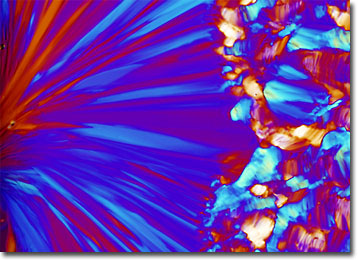Polarized Light Microscopy Digital Image Gallery
Atropine
Atropine is a poisonous alkaloid that occurs naturally in belladonna and several other plants of the nightshade family, Solanaceae. The substance may be derived from these plants for medical use, but in recent years, it has become an increasingly common practice to utilize synthetic substitutes instead.

Chemically similar in some regards to acetylcholine, within the body, atropine interferes with the nerve impulses normally conveyed by the neurotransmitter. The effects resulting from this action are numerous and diverse. Inhibition of the vagus nerve, for instance, usually causes an increase in heart rate, while the relaxation of smooth muscle comprising the bronchial tubes as well as the drying of saliva and nasal secretions clear the air passages and make breathing easier. Atropine also eases spasms in the intestines and dilates the pupils. Other, less desirable, effects of atropine usage may include light-headedness, dizziness, confusion, soreness of the eyes, and skin rash.
The primary medical uses of atropine have changed somewhat over the years. The drug, for instance, was once heavily utilized as respiratory stimulant, but relatively recently the hormone epinephrine has become the preferred treatment for bronchial asthma and similar conditions. One of the chief reasons for the decrease in the popularity of atropine for some purposes is the wide array of effects produced by the drug, the medical community increasingly coming to favor synthetic drugs that generate a similar, but narrower, range of corollaries. Nevertheless, atropine is still often utilized in several applications, such as the preparation for general anesthetic, the treatment of bedwetting, the control of heart function, and the dilation of the eyes for vision screenings.
